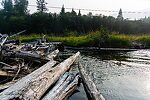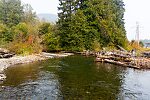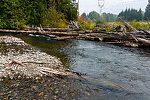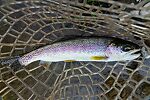Blog & Latest Updates
Fly Fishing Articles
Insects by Common Name


> > Quick evening on the upper Yakima
Quick evening on the upper Yakima
With smoke from the west coast wildfires beginning to clear just a little, I took a few hours to fish one of the nearest access points on the Yakima River, where the fish are small and the water uncrowded. There were some stoneflies and caddisflies in the air--I collected one of each, representing the most abundant species--but there weren't enough bugs on the water to get the fish rising, except for the abundant 3-inch-long Chinook Salmon parr. I continued playing around with my new Euro nymphing rig and landed several rainbows up to 12", including my first double on that rod.
Photos by Troutnut from the Yakima River in Washington
Closeup insects by Troutnut from the Yakima River in Washington
Male Onocosmoecus unicolor (Great Late-Summer Sedge) Caddisfly Adult View 15 PicturesI first just assumed this was Dicosmoecus based on anglers' conventional wisdom since it's a large orange "October caddis," but Creno set me straight. I should have keyed it out. After another look under the microscope, it lacks an anepisternal wart on the mesopleuron (Mesopleuron: The side of the insect mesothorax, and the part to which the fore wings are attached in mayflies.), which rules out Dicosmoecus. The midtibiae have 2 apical (Apical: Close to the apex; tip or end.) spurs and 1 pre-apical (Apical: Close to the apex; tip or end.) spur, and from there the color pattern of the wing points to Onocosmoecus. The location then narrows the species to unicolor.
View 15 PicturesI first just assumed this was Dicosmoecus based on anglers' conventional wisdom since it's a large orange "October caddis," but Creno set me straight. I should have keyed it out. After another look under the microscope, it lacks an anepisternal wart on the mesopleuron (Mesopleuron: The side of the insect mesothorax, and the part to which the fore wings are attached in mayflies.), which rules out Dicosmoecus. The midtibiae have 2 apical (Apical: Close to the apex; tip or end.) spurs and 1 pre-apical (Apical: Close to the apex; tip or end.) spur, and from there the color pattern of the wing points to Onocosmoecus. The location then narrows the species to unicolor.
 View 15 PicturesI first just assumed this was Dicosmoecus based on anglers' conventional wisdom since it's a large orange "October caddis," but Creno set me straight. I should have keyed it out. After another look under the microscope, it lacks an anepisternal wart on the mesopleuron (Mesopleuron: The side of the insect mesothorax, and the part to which the fore wings are attached in mayflies.), which rules out Dicosmoecus. The midtibiae have 2 apical (Apical: Close to the apex; tip or end.) spurs and 1 pre-apical (Apical: Close to the apex; tip or end.) spur, and from there the color pattern of the wing points to Onocosmoecus. The location then narrows the species to unicolor.
View 15 PicturesI first just assumed this was Dicosmoecus based on anglers' conventional wisdom since it's a large orange "October caddis," but Creno set me straight. I should have keyed it out. After another look under the microscope, it lacks an anepisternal wart on the mesopleuron (Mesopleuron: The side of the insect mesothorax, and the part to which the fore wings are attached in mayflies.), which rules out Dicosmoecus. The midtibiae have 2 apical (Apical: Close to the apex; tip or end.) spurs and 1 pre-apical (Apical: Close to the apex; tip or end.) spur, and from there the color pattern of the wing points to Onocosmoecus. The location then narrows the species to unicolor.Collected September 17, 2020 from the Yakima River in Washington
Added to Troutnut.com by Troutnut on September 19, 2020
Added to Troutnut.com by Troutnut on September 19, 2020
Female Isoperla fusca (Yellow Sally) Stonefly Adult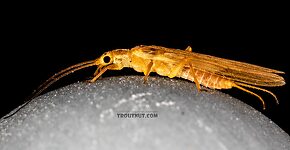 View 13 PicturesThe family ID on this one was a little bit tricky. Just going by the size, shape, and color, it looks like Chloroperlidae. However, the second anal vein of the forewing is does not appear to be forked, and the apical (Apical: Close to the apex; tip or end.) maxillary palpal segment is close to the length of the penultimate segment, both of which rule out that family. The position of the cubitoanal crossvein (Crossvein: Short cross-wise veins in an insect wing which connect the long longitudinal (length-wise) veins.) relative to the anal cell in the forewing -- touching it in this case -- indicates Perlidae (and it really doesn't have the "look" of Perlidae at all), but other characteristics, such as the metathorastic sternacostal sutures and lack of gill remnants, point to Perlodidae. That's the right answer. Moving on to Perlodidae, the key characteristics in Merritt & Cummins lead straightforwarly to Isoperla, and the species key in Jewett 1959 (The Stoneflies of the Pacific Northwest) leads to Isoperla fusca.
View 13 PicturesThe family ID on this one was a little bit tricky. Just going by the size, shape, and color, it looks like Chloroperlidae. However, the second anal vein of the forewing is does not appear to be forked, and the apical (Apical: Close to the apex; tip or end.) maxillary palpal segment is close to the length of the penultimate segment, both of which rule out that family. The position of the cubitoanal crossvein (Crossvein: Short cross-wise veins in an insect wing which connect the long longitudinal (length-wise) veins.) relative to the anal cell in the forewing -- touching it in this case -- indicates Perlidae (and it really doesn't have the "look" of Perlidae at all), but other characteristics, such as the metathorastic sternacostal sutures and lack of gill remnants, point to Perlodidae. That's the right answer. Moving on to Perlodidae, the key characteristics in Merritt & Cummins lead straightforwarly to Isoperla, and the species key in Jewett 1959 (The Stoneflies of the Pacific Northwest) leads to Isoperla fusca.
There is one caveat: That source does suggest a May-July emergence, whereas this one was collected in mid-September.
 View 13 PicturesThe family ID on this one was a little bit tricky. Just going by the size, shape, and color, it looks like Chloroperlidae. However, the second anal vein of the forewing is does not appear to be forked, and the apical (Apical: Close to the apex; tip or end.) maxillary palpal segment is close to the length of the penultimate segment, both of which rule out that family. The position of the cubitoanal crossvein (Crossvein: Short cross-wise veins in an insect wing which connect the long longitudinal (length-wise) veins.) relative to the anal cell in the forewing -- touching it in this case -- indicates Perlidae (and it really doesn't have the "look" of Perlidae at all), but other characteristics, such as the metathorastic sternacostal sutures and lack of gill remnants, point to Perlodidae. That's the right answer. Moving on to Perlodidae, the key characteristics in Merritt & Cummins lead straightforwarly to Isoperla, and the species key in Jewett 1959 (The Stoneflies of the Pacific Northwest) leads to Isoperla fusca.
View 13 PicturesThe family ID on this one was a little bit tricky. Just going by the size, shape, and color, it looks like Chloroperlidae. However, the second anal vein of the forewing is does not appear to be forked, and the apical (Apical: Close to the apex; tip or end.) maxillary palpal segment is close to the length of the penultimate segment, both of which rule out that family. The position of the cubitoanal crossvein (Crossvein: Short cross-wise veins in an insect wing which connect the long longitudinal (length-wise) veins.) relative to the anal cell in the forewing -- touching it in this case -- indicates Perlidae (and it really doesn't have the "look" of Perlidae at all), but other characteristics, such as the metathorastic sternacostal sutures and lack of gill remnants, point to Perlodidae. That's the right answer. Moving on to Perlodidae, the key characteristics in Merritt & Cummins lead straightforwarly to Isoperla, and the species key in Jewett 1959 (The Stoneflies of the Pacific Northwest) leads to Isoperla fusca. There is one caveat: That source does suggest a May-July emergence, whereas this one was collected in mid-September.
Collected September 17, 2020 from the Yakima River in Washington
Added to Troutnut.com by Troutnut on September 19, 2020
Added to Troutnut.com by Troutnut on September 19, 2020
Quick Reply
You have to be logged in to post on the forum. It's this easy:
Troutnut.com is copyright © 2004-2024 Jason
Neuswanger (email Jason). See my FAQ for information about use of my images.
 privacy policy
privacy policy


